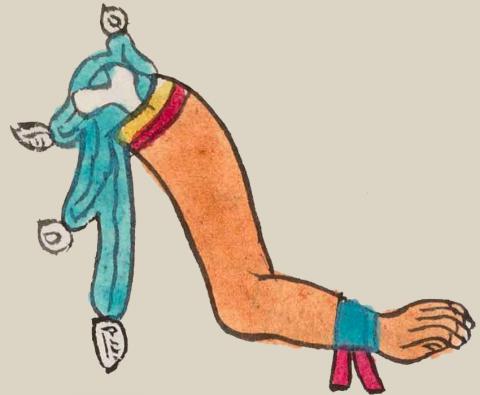Acolhuacan (Mdz21v)
This compound glyph for the place name Acolhuacan is an arm with the left hand on the right and a white bone protruding on at the point of the shoulder (acolli), or (ahcōlli), with the diacritics added. On the wrist is a turquoise band with a red (probably leather) tie. At the top of the arm, near the bone, are a red and yellow line. Turquoise blue water (at) or ātl) (with its typical lines of current and turbinate shells and droplets or chalchihuitl beads splashing off the flow) comes out of the top of the arm, surrounding the bone, and cascades downward. The locative suffix -cān is not shown visually.
Stephanie Wood
The phonetic complement "a" from atl) or ātl) tips us off that this arm image refers to the acolli or ahcōlli as opposed to the hand (maitl), for instance. Just below the protrusion are bands of yellow and red that are reminiscent of the bottom of the tepetl (mountain), where water can emerge, like a spring. See Ixicayan, as an example. The possession or containment implied by -hua- (or -huah) does not have an obvious visual representation in this glyph for Acolhuacan. The red and turquoise bracelet on the wrist of this arm may be emblematic of the Acolhua people, and the colors suggest status and preciosity.
Stephanie Wood
acolhuacā, puo
Acolhuacan, pueblo
Stephanie Wood
c. 1541, or by 1553 at the latest
Stephanie Wood
arms, shoulders, hands, bracelets, bones, water, shells, brazos, manos, braceletes, huesos, agua, conchas, pueblos, nombres de lugares, hueso

a(tl), water, https://nahuatl.wired-humanities.org/content/atl
acol(li), shoulder, https://nahuatl.wired-humanities.org/content/acolli
coltic, curved, https://nahuatl.wired-humanities.org/content/coltic
-hua- (possession or containment), https://aztecglyphs.wired-humanities.org/content/hua
-can (locative suffix), https://nahuatl.wired-humanities.org/content/can-2
ma(itl), hand or arm, https://nahuatl.wired-humanities.org/content/maitl
"Place of the Acolhua" (Berdan and Anawalt, and also supported by Frances Karttunen. Karttunen adds that the vowel length and glottal stops are not shown visually. [Frances Karttunen, unpublished manuscript, used here with her permission.]
"Place of the Acolhua People" (Berdan and Anawalt, 1992, vol. 1, p. 169)
"El Lugar de los Acolhua"
Stephanie Wood
Codex Mendoza, folio 21 verso, https://digital.bodleian.ox.ac.uk/objects/2fea788e-2aa2-4f08-b6d9-648c00..., image 53 of 188.
The Bodleian Libraries, University of Oxford, hold the original manuscript, the MS. Arch. Selden. A. 1. This image is published here under the UK Creative Commons, “Attribution-NonCommercial-ShareAlike 3.0 License” (CC-BY-NC-SA 3.0).




